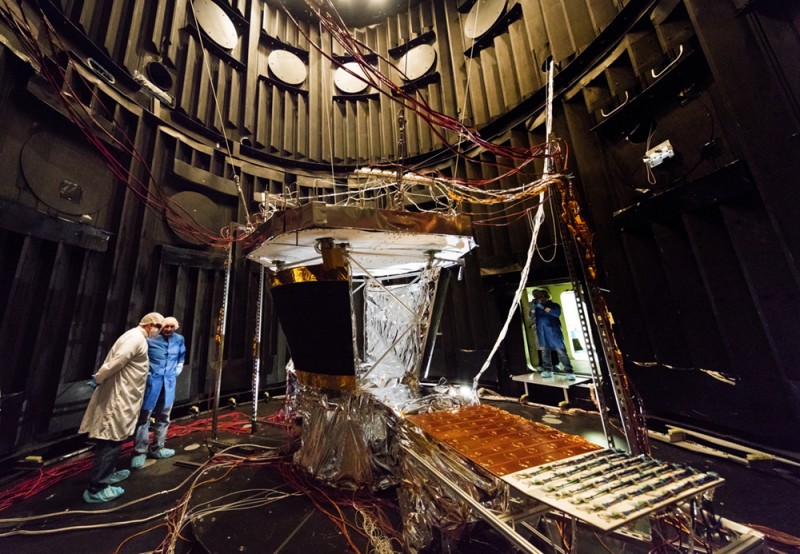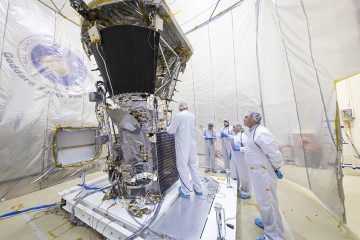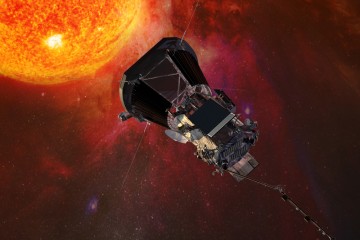In 1958, a solar astrophysicist named Eugene Parker submitted a paper to Astrophysical Journal that predicted the existence of the solar wind, a supersonic stream of highly charged particles flowing from the sun. Two of the journal's reviewers rejected the paper because they thought Parker's math was wrong—what else could explain such an absurd conclusion? But the journal's editor overruled them and published the paper. Subsequent satellite observations supported Parker's ideas.
Video credit: JHU Applied Physics Laboratory
That same year, scientists proposed sending a spacecraft to the sun to study the solar wind, as well as the astonishingly hot corona, the bright halo around the sun that was spectacularly on view during the recent total solar eclipse. But there was an obvious technical challenge—how to fly close enough to the sun to do the science without burning up. Six decades after the mission was first proposed, scientists and engineers believe they have solved the problem and are building a spacecraft that they say, with a bit of poetic license, will touch the sun.
If all goes well, the newly named Parker Solar Probe, now being assembled at the Johns Hopkins Applied Physics Laboratory, will launch in mid-2018. It will swoop within 4 million miles of the sun's surface, seven times closer than any previous probe and near enough to fly through the sun's atmosphere and make unprecedented observations of the corona and solar wind. The mission plan calls for 24 orbits of the sun.
The key piece of engineering that will permit two dozen close flybys is the heat shield, developed by APL and the Whiting School of Engineering. The disk-shaped shield is nearly 8 feet across but only 4 inches thick, composed of a carbon graphite sheet affixed to carbon foam blocks. During the closest encounters with the sun, the surface temperature of the shield will exceed 2,500 degrees Fahrenheit. But because the carbon-carbon composite shield is such a poor heat conductor, the scientific instruments behind it will stay at about room temperature, albeit a really warm room.
An additional coolant system will flow water through the solar panels that generate the spacecraft's electric power. During launch and the initial stage of the voyage, the spacecraft will be subject to extreme cold, so the water will be held in an accumulator tank to keep it above freezing. APL's Jim Kinnison, the mission system engineer, notes wryly, "It's pretty surprising on a mission going to the sun that one of our bigger worries is something freezing."

Image caption: The solar array cooling system for the Parker Solar Probe spacecraft is shown undergoing thermal testing at NASA Goddard Space Flight Center in Greenbelt, Maryland, in late February.
Image credit: NASA/JHUAPL
Another challenge will be quickly dealing with anything that might go wrong. During each solar encounter, there will be a period of about 11 days when communication with the craft is impossible because of the massive amount of radio noise generated by the sun. Mission scientists and engineers have had to imagine every possible problem that might befall the spacecraft, then program its computers to respond, either solving the problem autonomously or at least putting the craft in a safe mode that will preserve it long enough for flight controllers at APL to fix the problem from Earth, once they're back in contact.
The Parker Solar Probe will help answer some fundamental questions about the sun. For example, the temperature of the sun's surface—surface meaning the layer of gas, called the photosphere, that forms the disk we see from Earth—is about 10,000 degrees Fahrenheit. But the heat of the corona reaches 3.5 million degrees. How can something farther away from the sun's nuclear furnace be so much hotter? Then there's the extraordinary velocity of the solar wind, which at its peak exceeds 450 miles per second. What's generating such speed? What is the structure of the solar wind that close to the sun? Why is there a fast solar wind and a slower solar wind?
The 20-day launch window for the mission opens on July 31, 2018. Six weeks after launch, the probe will swing by Venus, using its gravity as a brake to drop into a closer solar orbit. The first encounter with the sun will take place six weeks after that; the last one will occur in 2025. Recalling that the mission was first proposed in 1958, APL project scientist Nicola Fox says, "It's taken 60 years, but we've got this."
Posted in Science+Technology











